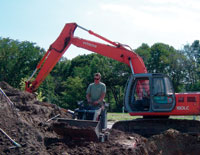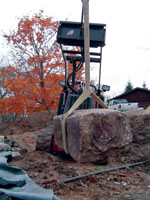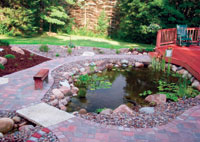Making Waves
 Nothing alleviates the heat of summer like enjoying the cool confines of a water feature. A water garden, or pond, can be an enviable feature for a home’s exterior — it can provide a soothing environment for the homeowner and can add significantly to a home’s value. But building a pond can be an arduous task, even for a pro. It can take days or may even stretch over several weeks.
Nothing alleviates the heat of summer like enjoying the cool confines of a water feature. A water garden, or pond, can be an enviable feature for a home’s exterior — it can provide a soothing environment for the homeowner and can add significantly to a home’s value. But building a pond can be an arduous task, even for a pro. It can take days or may even stretch over several weeks.
Pond construction is physically grueling. The conventional back-breaking method of building a small water garden is usually with a shovel, mattock and wheelbarrow. So pond builders are always looking for tools and tricks of the trade that will help them build better ponds faster and easier. And today, some pond builders may have found a new alternative — compact utility loaders.
From Start to Finish
Michael Otte, owner of Whitewater Gardens in St. Charles, Minn., has been building ponds for six years. Otte, a certified Aquascape designer, discovered early on that a compact utility loader was the key to growing his business, letting him create a more professional-looking pond in less time.
“When I was first starting out, I worked for a contractor who owned a compact loader but never used it because the crew was still using their heavier machines, like skid steers and trenchers,” says Otte. “I asked if I could give the loader a try on a couple of pond-building projects, and the first time I used it, I knew it could change the way I do business.”

According to Otte, compact utility loaders are ideal tools to use in pond construction. Because of the variety of attachments available, these mighty machines offer pond-building contractors added versatility including: digging the pond; hauling and placing boulders, gravel and rocks; carrying tools and equipment to and from the jobsite; installing waterfalls; putting together the surrounding landscape; and even cleaning up afterward. And because of the loaders’ light footprint and compact size, they minimize disruption to the existing landscape because they don’t tear up the ground while working around the yard, and they can work right up beside foundations, walls and fences.
On many projects, Otte’s compact utility loader is used in every step of the building process. With a bucket attachment, Otte digs out the pond basin and hauls boulders and other materials to the site. In fact, shuttling materials is one of the loader’s main functions. With the loader, he can move rocks up to 1,000 lbs around the site with relative ease. He uses a multi-purpose tool with swivels and straps to then carefully set larger boulders in place. This attachment is invaluable, says Otte, because it is important to avoid damaging the fragile rubber membrane that lines the water gardens while placing the boulders. Also, he makes use of forks to set boulders higher up in his waterfall designs. Otte also uses his loader with one of three bucket attachments to construct berms behind the waterfalls, as well as to backfill and smooth out the terrain during the cleanup phase.
With the right attachments, Otte knows his compact utility loader could be used for many other tasks around the jobsite. For example, with a trencher attachment, he could lay the plumbing in his pond creations. He could use the backhoe attachment for excavation and backfill work and a vibratory plow attachment would make short work of any irrigation project.
Tools of the Trade

“The design of the project really dictates how long it will take to complete,” says Otte. “The terrain, the amount of digging, the size of the water feature, access to the site and any obstacles all go into my planning. Also, weather is a big factor in how quickly I can complete a project. As a small business owner, having the machine to do the job is invaluable.”
Otte sees a lot of contractors using larger, heavier machines to build ponds and knows there is a more efficient way. “I see a lot of landscapers expanding their business by building water gardens and show up with a skid steer and make a big mess. They have way more machine than they need, and it’s too big to maneuver around backyards without tearing things up.”
The compact utility loader’s small size and light footprint really appealed to Otte when he was choosing a machine to build his business. Because a compact utility loader is not as large or heavy as other machines, Otte says he easily can maneuver next to houses and through backyard gates, creating a professional finish with minimal disruption to the existing landscape. Another advantage of the compact utility loader is the visibility — he can see all around the machine during operation, and he’s able to look right at what he’s working on. This allows him to be more specific with the machine’s operation.
Otte tested several different models before buying. He was looking for a machine that he could transport with a ½-ton pickup and enclosed trailer — equipment he already had in his fleet. Also, he wanted a loader that had the lift and carrying capacity to move large boulders.
“The ability to appropriately install large rock is what separates professional contractors from homeowners,” reveals Otte. “I was also looking for a machine that had highly responsive hydraulics and an aggressive powertrain. I was looking for good engagement from a loader.”

“Having one compact loader in my fleet is enough to make my company profitable,” says Otte. “It replaces a couple of guys and it doesn’t call in sick, so that lowers my overhead costs. It saves me a lot of physical labor, and it doesn’t tell my competitors my secrets.”
Amber Reed is a technical writer for Performance Marketing, West Des Moines, Iowa.





Comments are closed here.